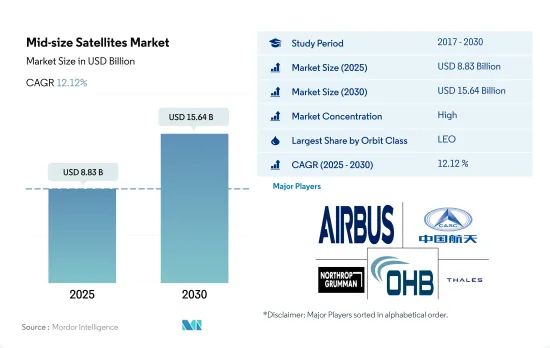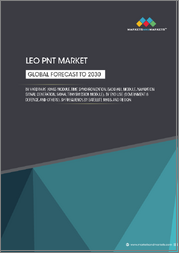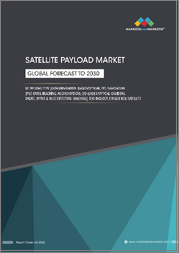
|
시장보고서
상품코드
1693956
세계의 중형 위성 : 시장 점유율 분석, 산업 동향 및 통계, 성장 예측(2025-2030년)Mid-size Satellites - Market Share Analysis, Industry Trends & Statistics, Growth Forecasts (2025 - 2030) |
||||||
중형 위성 시장 규모는 2025년 88억 3,000만 달러, 2030년에는 156억 4,000만 달러에 달할 것으로 예상되며, 예측 기간(2025-2030년) 동안 12.12%의 연평균 복합 성장률(CAGR)을 보일 것으로 예측됩니다.

중소형 위성의 개발 증가로 2023-2029년 LEO 위성 채택률 증가 전망
- 500-1,000kg의 중형 위성이 LEO 궤도에서 발사되고 있으며, 예측 기간 동안에도 LEO 궤도는 2017년 85.3%로 시장 점유율의 대부분을 차지했습니다.
- 용도와 임무 유형에 따라 특정 위성이나 위성 별자리 전체가 다양한 유형의 궤도로 발사됩니다. 모든 지역에서 제작 및 발사되는 위성은 용도가 다릅니다. 예를 들어, 2017-2022년 사이에 발사된 167개의 대형 위성 중 114개, 43개, 8개, 2개가 각각 LEO, MEO, GEO, 타원궤도에 배치되었습니다.
- 시장 점유율은 LEO 궤도가 2023년 84%, 2029년 83.1%의 점유율을 차지하며 시장을 주도할 것으로 예측됩니다. GEO 궤도는 2023년 9%, 2029년 7%의 점유율을 기록할 것으로 예상되며, GEO 궤도는 2023년 9%, 2029년 7%의 점유율을 차지할 것으로 예측됩니다.
- 전자 정보, 지구과학/기상학, 레이저 이미징, 광학 이미징, 기상학 등의 분야에서 위성의 활용도가 높아지는 등 위성의 다기능 능력은 예측 기간 동안 이러한 위성의 개발 수요를 촉진할 것으로 예측됩니다.
- 세계 중형위성 시장은 통신, 정부, 국방 등 다양한 산업에서 위성 기반 서비스에 대한 수요가 증가함에 따라 안정적인 성장세를 보일 것으로 예측됩니다. 북미는 중형위성의 가장 큰 시장이며, 미국이 크게 기여하고 있습니다. 미국 정부는 군사 및 정보 목적의 중형 위성의 주요 고객입니다. 유럽의 중형 위성 시장은 특히 자동차 및 운송 산업에서 위성 기반 내비게이션 서비스에 대한 수요 증가에 힘입어 성장세를 보이고 있습니다. 아시아태평양의 중형 위성 시장은 위성을 이용한 통신 및 원격 감지 서비스에 대한 수요 증가가 주도하고 있습니다. 기타 중형 위성 시장 역시 지방 및 원격지에서의 위성 기반 통신 수요 증가로 인해 성장세를 보이고 있습니다.
- 세계 중형 위성 시장은 위성 부품의 소형화, 보다 효율적인 추진 시스템 개발 등 몇 가지 트렌드를 목격하고 있습니다. 위성 부품의 소형화로 중형 위성의 제조 및 발사 비용이 절감되고 있습니다. 이로 인해 특히 개발도상국의 중형위성 수요가 증가할 것으로 예측됩니다. 또한, 정부 및 민간기업의 우주산업에 대한 투자 증가도 시장을 견인하고 있습니다. 전반적으로, 다양한 산업 및 지역에서의 위성 기반 서비스에 대한 수요 증가로 인해 시장은 향후 몇 년 동안 안정적인 성장을 지속할 것으로 예측됩니다. 또한, 소형화된 위성 부품의 개발 등 위성 기술의 발전도 시장 활성화에 기여할 것으로 예측됩니다.
세계 중형위성 시장 동향
지구관측, 영상처리, 커넥티비티 서비스에 대한 수요 증가로 중형위성 카테고리의 연구개발비가 급증할 것으로 예측됩니다.
- 최근 전 세계적으로 발사 및 개발 중인 중형 위성 미션의 수가 크게 증가하고 있습니다. 이는 기술 발전으로 인해 이런 유형의 위성을 제작하고 발사하는 것이 더 저렴하고 친숙해졌기 때문입니다. 그 결과, 이 부문의 R&D 비용은 꾸준히 증가하고 있습니다. 유럽 국가들은 우주 분야에서의 다양한 투자의 중요성을 인식하고 있으며, 세계 우주 산업에서 경쟁력과 혁신성을 유지하기 위해 지구관측, 위성 항법, 연결성, 우주 연구, 기술 혁신 등의 부문에 대한 지출을 늘리고 있습니다.
- 2022년 11월, 유럽우주기구(ESA)는 지구관측에서 유럽의 주도권을 유지하고, 항법 서비스를 확대하며, 미국과의 탐사 파트너가 되기 위해 향후 3년간 우주 자금을 25% 증액할 것을 제안했다고 발표했습니다. 유럽우주기구(ESA)는 22개국에 2023-2025년 185억 유로의 예산을 지원해 줄 것을 요청했습니다. 마찬가지로 2022년 9월, 프랑스는 유럽우주기구가 자체 예산 증액에 대한 약속을 확보하기 위해 노력하는 가운데, 국가 및 유럽 우주 프로그램에 대한 지출을 늘릴 것이라고 발표했습니다. 정부는 지난 3년간 약 25% 증가한 90억 달러 이상을 우주 활동에 할당할 계획이라고 발표했습니다.
- 2017-2022년 전 세계적으로 약 320개 이상의 위성이 제작 및 발사될 것으로 예측됩니다. 전반적으로 중형위성 시장은 지구관측, 영상처리, 커넥티비티 서비스 수요 증가에 힘입어 지속적으로 성장할 것으로 예측됩니다.
중형위성 산업 개요
중형 위성 시장은 상당히 통합되어 있으며, 상위 5개 업체가 81.92%를 점유하고 있습니다. 이 시장의 주요 기업은 Airbus SE, China Aerospace Science and Technology Corporation(CASC), Northrop Grumman Corporation, OHB SE, Thales입니다.
기타 혜택
- 엑셀 형식 시장 예측(ME) 시트
- 3개월 애널리스트 지원
목차
제1장 주요 요약과 주요 조사 결과
제2장 보고서 오퍼
제3장 서론
- 조사의 전제조건과 시장 정의
- 조사 범위
- 조사 방법
제4장 주요 산업 동향
- 위성 질량
- 우주 개발 지출
- 규제 프레임워크
- 세계
- 호주
- 브라질
- 캐나다
- 중국
- 프랑스
- 독일
- 인도
- 이란
- 일본
- 뉴질랜드
- 러시아
- 싱가포르
- 한국
- 아랍에미리트(UAE)
- 영국
- 미국
- 밸류체인과 유통 채널 분석
제5장 시장 세분화
- 용도
- 통신
- 지구관측
- 내비게이션
- 우주관측
- 기타
- 궤도 클래스
- GEO
- LEO
- MEO
- 최종사용자
- 상업
- 군 및 정부
- 기타
- 추진 기술
- 전기식
- 가스
- 액체 연료
- 지역
- 아시아태평양
- 유럽
- 북미
- 기타
제6장 경쟁 구도
- 주요 전략 동향
- 시장 점유율 분석
- 기업 상황
- 기업 개요
- Airbus SE
- China Aerospace Science and Technology Corporation(CASC)
- Indian Space Research Organisation(ISRO)
- Northrop Grumman Corporation
- OHB SE
- ROSCOSMOS
- Thales
제7장 CEO에 대한 주요 전략적 질문
제8장 부록
- 세계 개요
- 개요
- Five Forces 분석 프레임워크
- 세계의 밸류체인 분석
- 시장 역학(DROs)
- 정보원과 참고 문헌
- 도표
- 주요 인사이트
- 데이터 팩
- 용어집
The Mid-size Satellites Market size is estimated at 8.83 billion USD in 2025, and is expected to reach 15.64 billion USD by 2030, growing at a CAGR of 12.12% during the forecast period (2025-2030).

Increased development of small and medium satellites is expected to drive the adoption rate of LEO satellites from 2023 to 2029
- Medium satellites or mid-size satellites weighing 500 to 1,000 kg are being launched in the LEO orbit and are expected to continue the same throughout the forecast period. LEO orbit occupied the majority of the market share of 85.3% in 2017.
- Depending on the type of application or mission, a particular satellite or an entire satellite constellation is launched in various types of orbit. Different satellites manufactured and launched across all the regions have different applications. For instance, during 2017-2022, out of the 167 large satellites launched, 114, 43, 8, and 2 were placed in LEO, MEO, GEO, and elliptical orbits, respectively.
- With respect to the market shares, LEO orbit is expected to lead the market, and it is expected to occupy a share of 84% in 2023 and 83.1% in 2029. The high market share is because of its close proximity and several other advantages triggered by technological developments. GEO orbit is expected to register a share of 9% in 2023, and it is anticipated to occupy a share of 7% in 2029.
- The multi-function capabilities of these satellites, such as the increasing uses of satellites in areas like electronic intelligence, Earth science/meteorology, laser imaging, optical imaging, and meteorology, are expected to drive the demand for the development of these satellites during the forecast period.
- The global mid-size satellite market is expected to grow at a steady pace due to the increasing demand for satellite-based services across various industries, such as telecommunications, government, and defense. North America is the largest market for mid-size satellites, with the United States being the major contributor. The US government is the major customer of mid-size satellites for military and intelligence purposes. The European mid-size satellite market is driven by the increasing demand for satellite-based navigation services, particularly in the automotive and transportation industries. The Asia-Pacific mid-size satellite market is being driven by a growing demand for satellite-based telecommunications and remote sensing services. The mid-size satellite market in the Rest of the World is also experiencing growth due to the increasing demand for satellite-based communications in rural and remote areas.
- The global mid-size satellite market is witnessing several trends, including the development of miniaturized satellite components and more efficient propulsion systems. The miniaturization of satellite components is reducing the cost of manufacturing and launching mid-size satellites. This is expected to increase the demand for mid-size satellites, particularly in developing countries. The market is also driven by the increasing investments by governments and private companies in the space industry. Overall, the market is expected to continue its steady growth in the coming years, driven by increased demand for satellite-based services across various industries and regions. The market is also expected to be fueled by advancements in satellite technology, including the development of miniaturized satellite components.
Global Mid-size Satellites Market Trends
Growing demand for Earth observation, imaging, and connectivity services is expected to surge the research and development expenditure in the mid size satellites category
- Over recent years, there has been a significant increase in the number of mid-size satellite missions launched and in development globally. This is largely due to advances in technology that have made it more affordable and accessible to build and launch these types of satellites. As a result, R&D expenditure in this area has been growing steadily. European countries are recognizing the importance of various investments in the space domain and are increasing their spending in areas such as Earth observation, satellite navigation, connectivity, space research, and innovation to stay competitive and innovative in the global space industry.
- In November 2022, ESA announced that it had proposed a 25% boost in space funding over the next three years designed to maintain Europe's lead in Earth observation, expand navigation services, and remain a partner in exploration with the United States. The European Space Agency (ESA) is requesting its 22 nations to back a budget of EUR 18.5 billion for 2023-2025. Likewise, in September 2022, France announced that it was expecting to increase spending on national and European space programs as the European Space Agency works to secure commitments for its own significant budget increase. The government announced that it planned to allocate more than USD 9 billion to space activities, an increase of about 25% over the past three years.
- During 2017-2022, around 320+ satellites were manufactured and launched globally. Overall, the mid-sized satellite market is expected to continue to grow, driven by the growing demand for Earth observation, imaging, and connectivity services.
Mid-size Satellites Industry Overview
The Mid-size Satellites Market is fairly consolidated, with the top five companies occupying 81.92%. The major players in this market are Airbus SE, China Aerospace Science and Technology Corporation (CASC), Northrop Grumman Corporation, OHB SE and Thales (sorted alphabetically).
Additional Benefits:
- The market estimate (ME) sheet in Excel format
- 3 months of analyst support
TABLE OF CONTENTS
1 EXECUTIVE SUMMARY & KEY FINDINGS
2 REPORT OFFERS
3 INTRODUCTION
- 3.1 Study Assumptions & Market Definition
- 3.2 Scope of the Study
- 3.3 Research Methodology
4 KEY INDUSTRY TRENDS
- 4.1 Satellite Mass
- 4.2 Spending On Space Programs
- 4.3 Regulatory Framework
- 4.3.1 Global
- 4.3.2 Australia
- 4.3.3 Brazil
- 4.3.4 Canada
- 4.3.5 China
- 4.3.6 France
- 4.3.7 Germany
- 4.3.8 India
- 4.3.9 Iran
- 4.3.10 Japan
- 4.3.11 New Zealand
- 4.3.12 Russia
- 4.3.13 Singapore
- 4.3.14 South Korea
- 4.3.15 United Arab Emirates
- 4.3.16 United Kingdom
- 4.3.17 United States
- 4.4 Value Chain & Distribution Channel Analysis
5 MARKET SEGMENTATION (includes market size in Value in USD, Forecasts up to 2030 and analysis of growth prospects)
- 5.1 Application
- 5.1.1 Communication
- 5.1.2 Earth Observation
- 5.1.3 Navigation
- 5.1.4 Space Observation
- 5.1.5 Others
- 5.2 Orbit Class
- 5.2.1 GEO
- 5.2.2 LEO
- 5.2.3 MEO
- 5.3 End User
- 5.3.1 Commercial
- 5.3.2 Military & Government
- 5.3.3 Other
- 5.4 Propulsion Tech
- 5.4.1 Electric
- 5.4.2 Gas based
- 5.4.3 Liquid Fuel
- 5.5 Region
- 5.5.1 Asia-Pacific
- 5.5.2 Europe
- 5.5.3 North America
- 5.5.4 Rest of World
6 COMPETITIVE LANDSCAPE
- 6.1 Key Strategic Moves
- 6.2 Market Share Analysis
- 6.3 Company Landscape
- 6.4 Company Profiles (includes Global Level Overview, Market Level Overview, Core Business Segments, Financials, Headcount, Key Information, Market Rank, Market Share, Products and Services, and Analysis of Recent Developments).
- 6.4.1 Airbus SE
- 6.4.2 China Aerospace Science and Technology Corporation (CASC)
- 6.4.3 Indian Space Research Organisation (ISRO)
- 6.4.4 Northrop Grumman Corporation
- 6.4.5 OHB SE
- 6.4.6 ROSCOSMOS
- 6.4.7 Thales
7 KEY STRATEGIC QUESTIONS FOR SATELLITE CEOS
8 APPENDIX
- 8.1 Global Overview
- 8.1.1 Overview
- 8.1.2 Porter's Five Forces Framework
- 8.1.3 Global Value Chain Analysis
- 8.1.4 Market Dynamics (DROs)
- 8.2 Sources & References
- 8.3 List of Tables & Figures
- 8.4 Primary Insights
- 8.5 Data Pack
- 8.6 Glossary of Terms

















